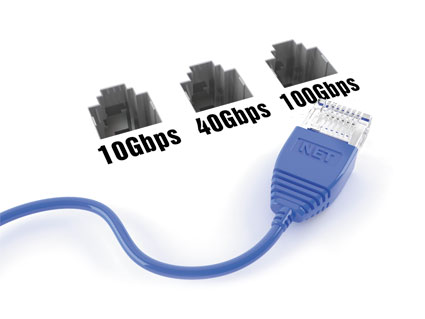
Super-fast transmission speeds are a boon to large corporate data centres, but the typical office network can get along quite nicely at a much lower cost.
Structured cabling systems were devised about 20 years ago in the United States as a Standards-based replacement for the plethora of vendor-specific building cabling systems.
Since that time, computer system architecture has evolved from being mainframe based, typically using coaxial cable reticulation, to LANs running Ethernet over twisted pair. In addition, Ethernet LAN technology, initially used in office environments only, has grown to the point where it is now found in every home.
The current applicable cabling Standards are EIA-568-C (US) and ISO 11801 (Europe and Australia). Transmission performance is guaranteed for various categories (EIA) or classes (ISO) of links and channels up to 100m in length.
The performance criteria in these Standards has been developed to guarantee support for particular types of Ethernet LAN protocols.
In addition, the IEEE 802.3 Standards series defines the media access control layer (MAC) and the physical layer of Ethernet. It too has evolved over the years thanks to ever-increasing LAN speeds, from the early days of 10Mbps systems to today’s 100Gbps fibre-based links.
Present-day cabling
Most of the structured cabling infrastructure found in the office or home today is Category 5e compliant. It is generally used for running 100BaseT or Gigabit Ethernet LAN services, plus legacy 10BaseT and analogue and digital telephony.
Cat 5e and Class D cabling specifications have been designed to guarantee support for Ethernet over twisted pair up to Gigabit speed. However, new installations tend to be Cat 6, as pricing for these has radically dropped in recent times.
In terms of advantages, Cat 6 offers performance headroom over Cat 5e, but for 100m links and channels it supports the same LAN protocols as Cat 5e (up to and including Gigabit Ethernet).
Cat 6A and 10G
Cabling compliant with Cat 6A must be used if support for 10G LANs with horizontal run lengths of up to 100m is to be guaranteed. This is equivalent to the ISO Class EA, with transmission performance parameters specified to 500MHz.
The latest ratified Cat 6A Standards are the EIA-568-C series and Amendment 1 to ISO/IEC 11801, Second Edition, 2008.
Existing Cat 6 installations can be reworked to support 10 Gigabit Ethernet over shorter distances (to about 50m). This is done by requalifying the installation according to procedures outlined in the TIA document TSB-155.
The procedures involve retesting the installation to Cat 6A specifications and, subject to the test results, some rework may be necessary. This may involve implementing alien crosstalk mitigation techniques and/or replacing some key components (e.g.: jacks) with higher-performing parts, thereby raising the link/channel performance.
Although Cat 6A cabling hardware and 10G terminal electronics have been available for some years, the cost is still prohibitive, to the point where it has held back commercial deployment on a large scale.
Terminating electronics also present issues. Even the modern PC fitted with the now popular GBE card has difficulty keeping up with the rate at which data is delivered, particularly during large file transfers. Consequently, the computer architecture required to support a bit stream 10 times faster than this is not trivial – or cheap.
Another issue holding back Cat 6A proliferation is the generally perceived absence of the need for speed. After all, most offices still run 100Mbps Ethernet.
We are being promised up to 100Mbps through the National Broadband Network – although most users will probably end up with much less – and this will provide high-definition TV and a host of other goodies.
So where are we going to use the 10G links that Cat 6A was designed to support? What office or home applications require such prodigious speeds? Apart from server to server links in a large computer room, I can’t think of any.
Other applications
The EIA Standard is aimed specifically at Ethernet applications running over twisted pair, with the RJ45 as the connector of choice. It focuses heavily on unshielded twisted pair (UTP), although shielded is accommodated in the specifications.
ISO, on the other hand, has tended to focus more on shielded cabling and opted not to limit cabling performance specifications to those required by Ethernet applications.
Thus ISO has defined two additional classes of cabling beyond Class EA (Cat 6A equivalent).
The Class F cabling specification (released in 2002) is specified to 600MHz and defines its own performance parameters for constituent components as ‘Category 7’. Note that EIA has no such definition.
Class F cabling uses individually shielded twisted pairs and achieves exceptional crosstalk performance in the cable. An allowance has been made for connections other than the RJ45, thus achieving superior crosstalk performance in the connecting hardware as well.
In terms of applications, Class F cabling will support 10G but at a substantial cost penalty compared with a UTP Cat 6A solution. Properly terminating all those individual shields involves a lot of work.
ISO has also defined a Class FA cabling system, with a corresponding component classification known as ‘Category 7A’. The system is specified for transmission performance to 1,000MHz (1GHz). Again, this is a fully shielded system with individually shielded pairs, using connectors other than RJ45.
As with Class F, the system was not designed to support any particular new application. Class FA is certainly capable of supporting 10G, but again at a substantial cost penalty when compared with UTP.
It will also support broadband CATV to 1GHZ, but this is hardly a killer application, as dedicated coax-based reticulation schemes will outperform it at a fraction of the cost.
Beyond 10G Ethernet
The Standards have been developed for Ethernet running at 40Gbps (40G) and at 100Gbps (100G). Copper and fibre-based solutions have been devised for both, but the copper implementations are limited to very short proposed distances (less than 10m).
Multi-mode and single mode fibre-based implementations are supported by the Standards for 40G and 100G, with a range of at least 100m for multi-mode fibre and 10km/40km for single mode, depending on the implementation.
This year, several companies have announced commercially available 100G single-mode fibre systems. These are still very new and, as far as I know, none are in commercial service (as at October 2011). All use wavelength division multiplexing to achieve these prodigious throughput rates.
Beyond 100G
The IEEE has started a group to study what should come after 100G Ethernet, once it is commonplace.
Known as the IEEE 802.3 Industry Connections Ethernet Bandwidth Assessment Ad Hoc Group, it was formed at the beginning of this year with the aim of simply gathering information for collation and future use by a Standards-setting body.
The group is collecting information on the way the world Ethernet networks are developing – the so-called Ethernet eco-system. This will enable an evaluation of future bandwidth needs for Ethernet wireline applications.
Of particular interest is the rate of high-speed Ethernet penetration into corporate networks and the projected traffic growth rates for up to 1G and 10G networks.
The two suggested target rates for future high-speed Ethernet are 400Gbps (400G) and 1 terabit per second (1T) Ethernet.
The key applications for links running at such mind-boggling speeds are to be found in the huge data centres run by organisations such as Google and Facebook, the New York Stock Exchange (NYSE) and internet exchanges – where global internet traffic is switched.
To enlarge on this a little, the NYSE has about 200,000 Ethernet ports running at 1G or below and 10,000 ports running at 10G, fed by 10,000 servers with 10 petabytes (that is 10,000 terabytes) of storage.
Clearly, technology is racing ahead, and with it the ever-increasing need for speed on the links that support large corporate data centres.
However, the typical office horizontal cabling system is another matter entirely. The need for high-speed links is simply not there.
Wireless versus copper
Wireless technology has been touted by some to become the replacement for fixed cabling. In my view the history of data communications does not support this assertion.
Over the past 20 years, structured cabling systems have moved from supporting 10Mbps to 10G, or a factor of 1,000 times faster. Over a similar period, wireless has gone from 11Mbps to 54Mbps, and just recently to 300Mbps, or not quite 30 times faster.
Physics plays a role here. By its very nature, RF spectrum is limited. This alone will limit the maximum possible throughput of wireless technology.
Furthermore, other wireless technologies such as DECT cordless telephony are beginning to compete for the same RF spectrum space. And finally, adjacent wireless LANs can and do interfere with each other, limiting the density of such networks. Fixed cabling has no such restrictions.
In my view, all these issues mean that wireless will never be able to supply the bandwidth now available on twisted-pair copper. Good old copper cabling will be with us for a long time yet, and 10G should serve us well for most commercial and domestic applications into the foreseeable future.





